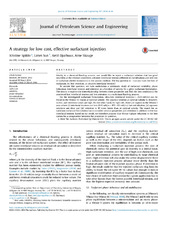A strategy for low cost, effective surfactant injection
Peer reviewed, Journal article
Published version
Permanent lenke
https://hdl.handle.net/1956/8858Utgivelsesdato
2014-05Metadata
Vis full innførselSamlinger
- Department of Chemistry [433]
Originalversjon
https://doi.org/10.1016/j.petrol.2014.03.006Sammendrag
Ideally, in a chemical flooding process, one would like to inject a surfactant solution that has good solubility at the relevant conditions, ultralow interfacial tension (efficient oil mobilisation) and low loss of surfactant (better economics) in the porous medium. The key question is – can you have low loss of surfactant, i.e. low retention, at ultralow interfacial tension? To answer this question, we have undertaken a systematic study of surfactant solubility, phase behaviour, interfacial tension and retention as a function of salinity for a given surfactant formulation. The idea is to explore the interrelationship between these properties and find the best condition(s) for combined low interfacial tension and low retention in a surfactant flooding process. For the investigated surfactant formulation, ultra-low interfacial tensions (<0.01 mN/m) can be found in the Winsor III region at optimal salinity. The aqueous solution at optimal salinity is, however, turbid, and retention values are high. On the other hand, for light oils, there are regions in the Winsor I area where (i) interfacial tensions are low (0.01 mN/m<IFT<0.1 mN/m), but not ultralow, (ii) aqueous solutions are clear and (iii) retention is 10 times lower than at optimal salinity. The search for an optimum surfactant formulation has to consider solution properties and retention in addition to the low interfacial tension. Based on our result, we therefore propose that Winsor I phase behaviour is the best option for a compromise between the properties in question.

